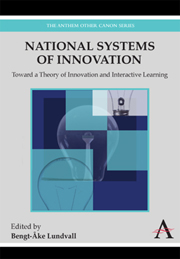Book contents
- Frontmatter
- Contents
- List of Tables
- List of Figures
- Preface
- 1 Introduction
- Part I Toward a New Approach to National Systems of Innovation
- Part II A Closer Look at National Systems of Innovation
- 5 Work Organisation and the Innovation Design Dilemma
- 6 Innovation and the Development of Industrial Networks
- 7 The Public Sector as a Pacer in National Systems of Innovation
- 8 The Role of Finance in National Systems of Innovation
- 9 Formal Scientific and Technical Institutions in the National System of Innovation
- Part III Opening National Systems of Innovation: Specialisation, Multinational Corporations and Integration
- Notes
- References
5 - Work Organisation and the Innovation Design Dilemma
from Part II - A Closer Look at National Systems of Innovation
Published online by Cambridge University Press: 05 March 2012
- Frontmatter
- Contents
- List of Tables
- List of Figures
- Preface
- 1 Introduction
- Part I Toward a New Approach to National Systems of Innovation
- Part II A Closer Look at National Systems of Innovation
- 5 Work Organisation and the Innovation Design Dilemma
- 6 Innovation and the Development of Industrial Networks
- 7 The Public Sector as a Pacer in National Systems of Innovation
- 8 The Role of Finance in National Systems of Innovation
- 9 Formal Scientific and Technical Institutions in the National System of Innovation
- Part III Opening National Systems of Innovation: Specialisation, Multinational Corporations and Integration
- Notes
- References
Summary
Some Initial Questions
As argued by Johnson in chapter 2 of this volume, learning ‘is the basic force behind technical innovation’. Learning is moulded by the operation of institutions reflected in the regularities of behaviour, which can be observed at different levels of aggregation within the economic system. This chapter focuses on the process of learning at the micro level with reference to the relationship between learning and work organisation and argues that the processes of intra-firm learning are contingent upon the type of work organisation in which learning takes place.
In order to evaluate the validity of this argument, one must ask: What are the institutional configurations of the type of work organisation in question, and to which type of learning do they relate in a contingent manner? Exploring the answer to this question is not at trivial matter, neither theoretically, nor empirically. Firstly, the answer cannot be obtained solely on the basis of the conceptual framework developed in part I of this volume, because the question touches upon issues requiring the application of organisation theory. However, this is not a problem, but an opportunity of inter-disciplinary cross-fertilisation, which will penetrate the discussion in this chapter. Secondly, the answer depends, obviously, upon the character of the specific case we are investigating. And thirdly, the question can be posed at several levels of aggregation, and the perspective need not be restricted to an individual firm or an operating unit, but may easily incorporate the most common principles of work organisation within an industry, a production system, or even a national system of innovation.
- Type
- Chapter
- Information
- National Systems of InnovationToward a Theory of Innovation and Interactive Learning, pp. 99 - 118Publisher: Anthem PressPrint publication year: 2010
- 1
- Cited by



